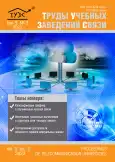Method of Throughput Calculation for Microwave Link with Adaptive Modulation Under the Fading Conditions Inherent for Millimeter Waves
- Authors: Stepanets I.V.1
-
Affiliations:
- The Bonch-Bruevich Saint-Petersburg State University of Telecommunications
- Issue: Vol 9, No 3 (2023)
- Pages: 91-103
- Section: Articles
- URL: https://journals.rcsi.science/1813-324X/article/view/254380
- ID: 254380
Cite item
Full Text
Abstract
About the authors
I. V. Stepanets
The Bonch-Bruevich Saint-Petersburg State University of Telecommunications
Email: stepanets.iv@sut.ru
ORCID iD: 0000-0003-1167-1590
References
- GPP TS 22.261 V19.1.0 (2022) Service requirements for the 5G system. Release 19.
- ITU-R M.2083-0 (2015) IMT Vision–Framework and overall objectives of the future development of IMT for 2020 and beyond.
- ETSI GR mWT 012 V1.1.1 (2018) 5G Wireless Backhaul/X-Haul.
- Степанец И.В., Степанец В.А., Зайчик Е.М., Одоевский С.М. 4. Особенности применения и планирования радиорелейной связи в сетях 5-го поколения // Информатизация и связь. 2019. № 3. С. 77‒83. doi: 10.34219/2078-8320-2019-10-3-77-83
- Методика расчета трасс цифровых РРЛ прямой видимости в диапазоне частот 2‒20 ГГц. Государственный Комитет Российской Федерации по связи и информации. Москва: Инженерный центр, 1998.
- ITU-R P.530-18 (2021) Propagation data and prediction methods required for the design of terrestrial line-of-sight systems.
- Одоевский С.М., Ключников В.О., Степанец И.В. Модель функционирования сети связи, построенной на основе радиорелейных станций с адаптивной модуляцией и коммутацией пакетов // Труды учебных заведений связи. 2021. Т. 7. №. 4. С. 63‒76. doi: 10.31854/1813-324X-2021-7-4-63-76
- Одоевский С., Степанец В. Проектирование РРЛ: программный комплекс ONEPLAN RPLS // Первая миля. 2016. № 8(61). С. 18‒23.
- ITU-R P.838-3 (2005) Specific attenuation model for rain for use in prediction methods. Question ITU-R 201/3.
- Рыбакова Ж.В. Физическая метеорология (отдельные разделы). Томск: Национальный исследовательский Томский государственный университет, 2013. 384 с.
- Агишева Д.К., Зотова С.А., Матвеева Т.А., Светличная В.Б. Математическая статистика: учебное пособие // Успехи современного естествознания. 2010. № 2. С. 122‒123.
- Вентцель Е.С., Овчаров Л.А. Теория вероятностей и ее инженерные приложения. М: Кнорус, 2018. 480 с.
- Введенский Б.А. (ред.). Физический энциклопедический словарь. М.: Советская энциклопедия, 1960. Т. 5.
- Вентцель Е.С. Теория вероятностей. М.: Наука, 1969.
- Ларин Е.А. Метод расчёта ослабления радиоволн в дожде на приземных трассах // Электросвязь. 1982. № 8. С. 48‒54.
- Абезгауз Г.Г. и др. Справочник по вероятностным расчетам. М.: Воениздат, 1970. 536 с.
Supplementary files






